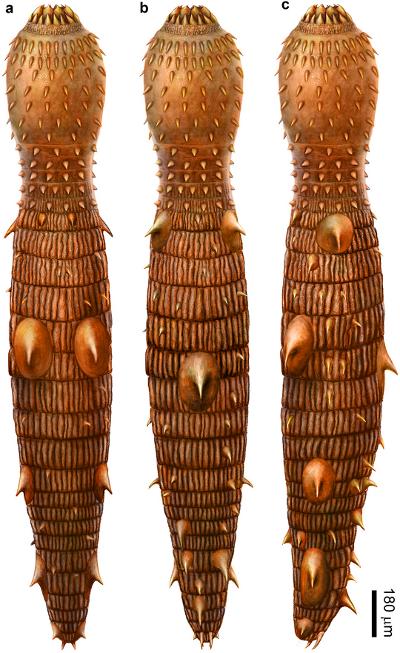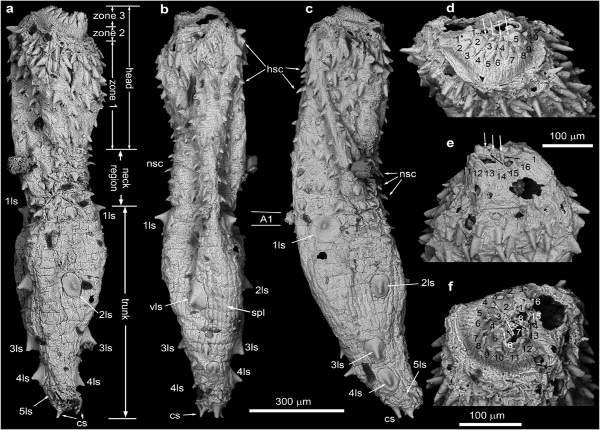This article was published in Scientific American’s former blog network and reflects the views of the author, not necessarily those of Scientific American
In the ocean muck of the world lives a little creature called a mud dragon. Though tiny -- none are larger than a millimeter -- were it our size, it would be a terrifying hell-beast feared and loathed by humans. It possesses an exoskeleton and segmented body surmounted by a head that plunges in and out, brandishing saber-like teeth.
Yet modern mud dragons are also kind of cute, in their quieter moments seeming to play a game of peek-a-boo in their own slightly horrible way.
On supporting science journalism
If you're enjoying this article, consider supporting our award-winning journalism by subscribing. By purchasing a subscription you are helping to ensure the future of impactful stories about the discoveries and ideas shaping our world today.
At least one of their ancestors, however, was not cute. It bears a striking resemblance to a certain desert-dwelling predator in a galaxy far, far away, were it turned inside out.

Art by Dinghua Yang at Nanjing Institute of Geology and Paleontology. Fig. 5 from Zhang et al. 2015.
This is an artist's reconstruction of a new fossil recently discovered in China. Finding this fossil mud dragon ancestor was quite a coup. Until it turned up, no other had been found, of any age, anywhere, ever.
It wasn’t for a lack of trying. Scientists had searched in vain for years. Mud dragons' closest presumed relatives -- the fascinating and only recently discovered loriciferans and the provacatively shaped priapulids (that would be the penis worms) -- have all been found abundantly fossilized as far back as the Cambrian, 540-485 million years ago. Yet “molecular clocks” based on steady rates of change among highly conserved proteins had suggested that mud dragons evolved around the same time as their relatives, probably in the Ediacaran, more than 550 million years ago. So it was hard to understand why their fossils were nowhere to be found.
Mud dragons are actually called “kinorhynchs”, which may be one of the most difficult English words to spell, and that’s saying a lot. I had to try about five times before I finally got it right. Kinorhynchs, mud dragons, or whatever you want to call them are tiny invertebrates that live in marine mud and sand. Today, there are only about 240 species and today, all are smaller than a millimeter. Considering that Kinorhyncha is a phylum – the same taxonomic rank as the Arthropods, the Chordates, or the Cnidaria, that’s not an awful lot of members.
Kinorynchs are essentially little armed and armored worms, as they have no appendages – just a head, neck, and body with exactly 11 segments. Not only is their external body segmented, so are their circular and longitudinal muscles and bundles of nerves called ganglia.
Although they look fearsome, the spines and hooks are not used so much for capturing prey as helping the limbless kinorhynch ratchet through the sediments in which it lives. First, it extends its head. The hooks on head and body catch on grains of mud or sand and pull the little animal forward when it next retracts its head.
On top of that head are sometimes two little eyespots, called ocelli. Lining the body are bristles that give the animal a sense of touch. And what does such a fearsome creature eat? Amazingly, and despite their impressive armament, kinorhynchs are vegetarians that eat either diatoms – little photosynthetic microbes encased in a glass pill-box like shell -- or organic detritus, i.e. bio-crud.
Although there are male and female kinorhynchs, and we know larvae live on their own in the wild, we don’t exactly know how little kinorhynchs are made. That's because no one has ever seen it happen.
Mud dragons seem to present an instance of body segmentation that evolved independently from the segmentation that emerged, for example, in Chordates or Arthropods. Kinorhynchs are also close relatives of arthropods, sharing an exoskeleton and segmented bodies with them, but lacking jointed legs. As a result, understanding their evolution could provide interesting insights into how and why segmentation evolves – and their fossils thus a tempting prize for scientists in search of data.
Scientists have searched in vain for kinorhynchs in places like the Burgess Shale, the famous British Columbian fossil bed that revealed to humans the glories of the Cambrian Explosion. But that may have been because they were looking in the wrong sort of sediment. The Burgess shale was preserved through compression of carbonaceous sediments on top of the organisms found there. But animals the size of kinorhynchs – around a millimeter or so – seem to be preserved much better through a process called phosphatization, in which calcium phosphate replaces the organic materials of the body.
And it was just such a phosphatized fossil bed in which the scientists recently discovered one whole and two partial unnamed forms of what sure looks like kinorhynchs from early Cambrian (~535 myo) rocks in Xinli and Xixiang sections, South China. The whole specimen has been name Eokinorhynchus rarus.

a-c, dorsal ventral, and lateral views of Eokinorhynchus rarus. d-f, closeups of head. cs= caudal spine, hsc= head scalid, ls= large slcerite, nsc= neck scalid, vls= ventral large scalid. Fig. 1 from Zhang et al. 2015.
The differences are few but notable. First, there are more body segments – at least 20 -- but the number is still small relative to animals like penis worms that have very many very tiny segments. As you'll recall, modern mud dragons have only 11 (I definitely think there is a market for “Modern Mud Dragon” magazine). And instead of having only small, thin cactus-like spines seen on modern mud dragons, the fossils appear to have wide, rose-like thorns ("large sclerites"), prominent in the reconstruction seen at the top of this post, and also visible in the image above (1ls-5ls).
The segments are also indicative of circular muscles, the authors say, which modern kinorhynchs have, but nematodes (a possible alternate ID for the fossils) do not. The spines on the part of the head that retracts are also arranged in five rows, the same as living kinorhynchs. Nematodes’ spines are arrayed in six rows.
If these fossils are indeed kinorhynchs, it confirms the ancient ancestry of the mud dragons long supposed by their close relatives’ fossil records. It also suggests it’s well worth looking for more of these tiny beasts in phosphatized fossil beds, and promises the potential of more material for the study of the many times segmentation has evolved on Earth.
Reference
Zhang, Huaqiao, Shuhai Xiao, Yunhuan Liu, Xunlai Yuan, Bin Wan, A. D. Muscente, Tiequan Shao, Hao Gong, and Guohua Cao. "Armored kinorhynch-like scalidophoran animals from the early Cambrian." Scientific reports 5 (2015).